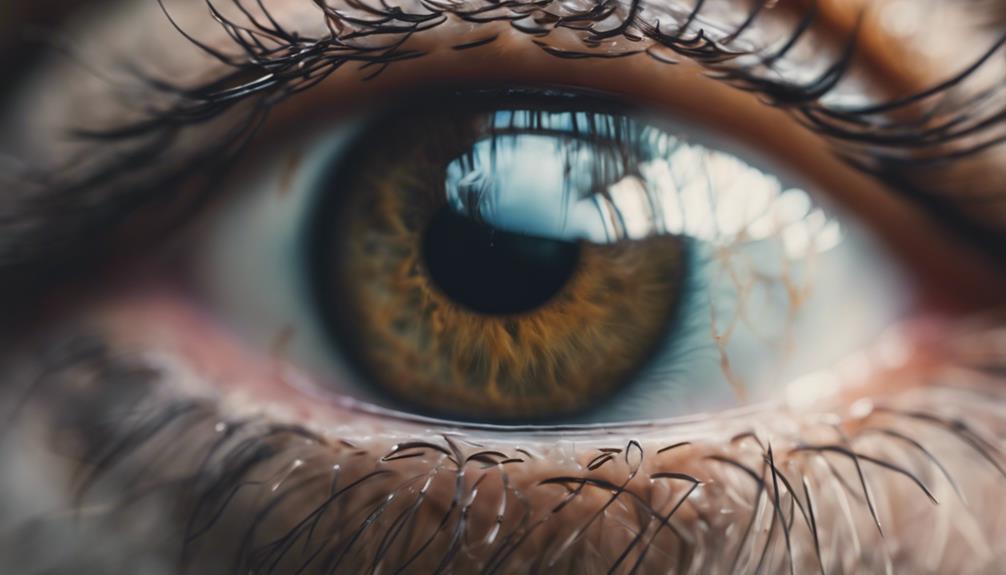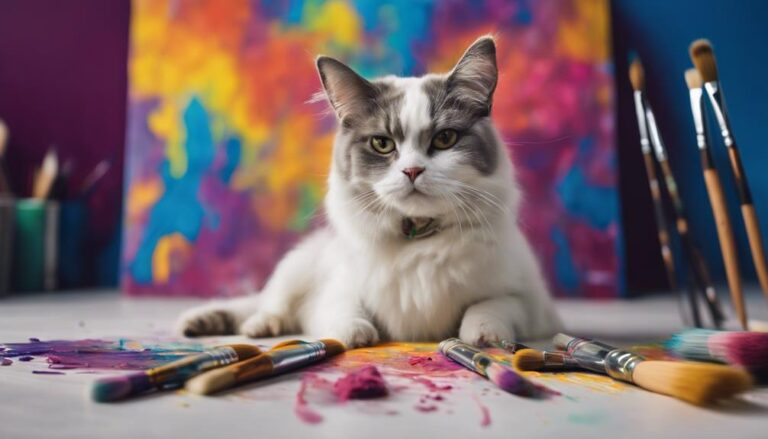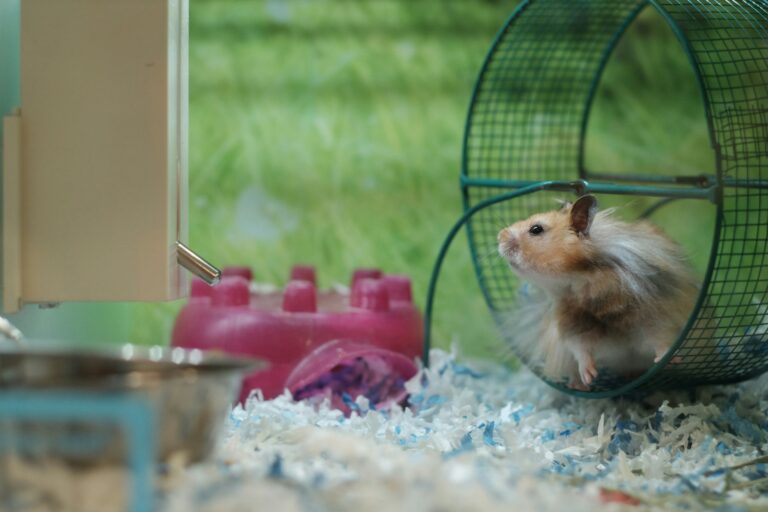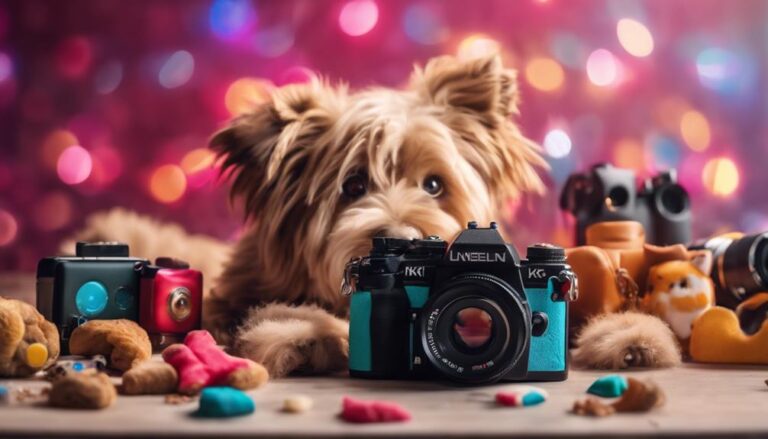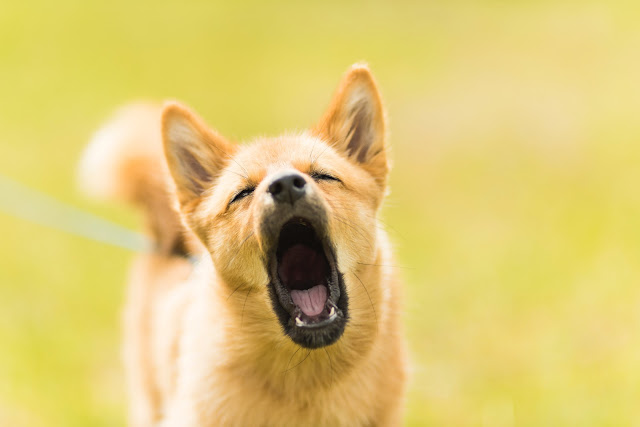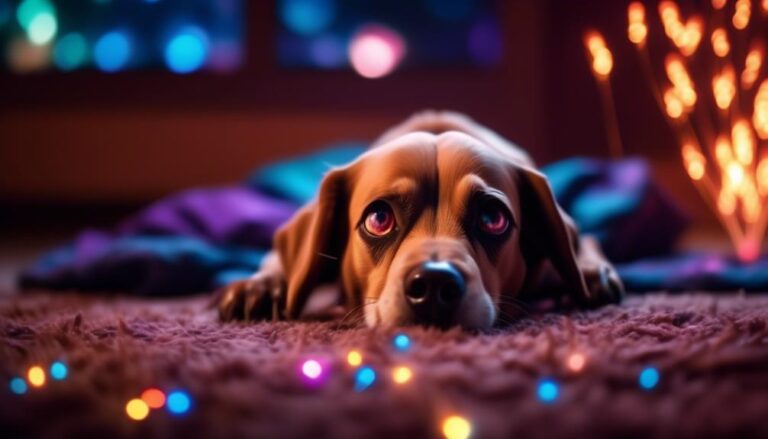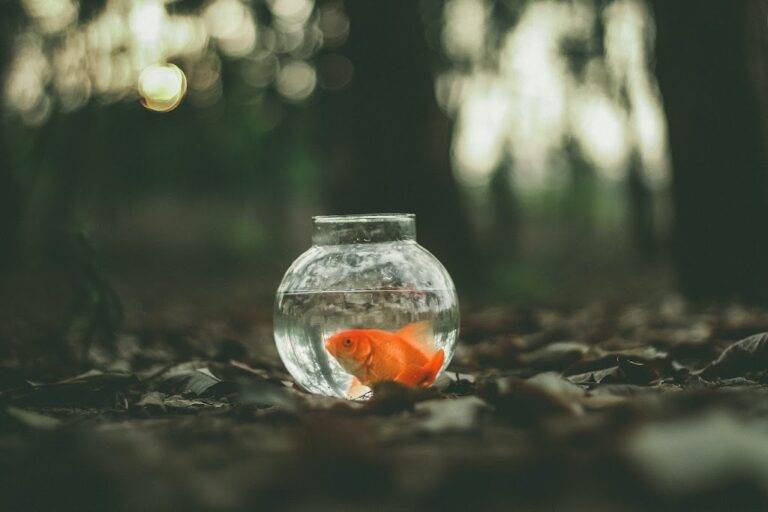When photographing your pet's eyes, position them in natural light for enchanting photos. Guarantee sharp focus on their eyes and experiment with different lighting techniques. Use a wide aperture to blur the background and isolate the eyes as the focal point. Pay attention to catchlights to enhance vibrancy and emotions. Position yourself at their eye level and avoid using flash. Experiment with post-processing techniques and different lenses for varied perspectives. Managing reflections and color contrast is vital for visual appeal. Mastering these tips can truly bring out your pet's personality in photos. More insights await on perfecting pet portraits.
Choose the Right Lighting
To capture the most engaging photographs of your pets' eyes, make sure that you position them in natural light for the best results. Natural lighting provides a soft and gentle illumination that enhances the details and colors of your pet's eyes. Avoid harsh artificial lighting as it can create stark shadows and unnatural color casts, resulting in less captivating photos. Whether you are indoors or outdoors, always opt for natural light whenever possible.
When photographing your pets' eyes, consider the difference between soft and harsh lighting. Soft lighting, like that from a window on a cloudy day, creates a diffused glow that is flattering and minimizes harsh shadows. This type of lighting is ideal for capturing the depth and emotion in your pet's eyes. On the other hand, harsh lighting, such as direct sunlight or bright artificial light, can be too intense and may cause your pet to squint or look uncomfortable in the photos.
Focus on the Eyes
When taking photos of pets, remember to focus on their eyes to create a compelling image. By ensuring the eyes are in sharp focus, you draw viewers to the most expressive part of the animal's face. Experiment with different lighting techniques to enhance the depth and emotion conveyed through the pet's eyes.
Eye Contact
Get your camera ready to capture the soulful expressions in your pet's eyes. When photographing your pet, pay attention to pupil dilation, as it can reflect their emotions and level of engagement with you. A dilated pupil may indicate excitement, fear, or interest, adding depth to the image. Additionally, consider your pet's eye shape, which can vary based on breed characteristics. Some breeds have round, expressive eyes, while others may have almond-shaped or prominent eyes. Understanding these features can help you frame the shot effectively, highlighting the unique aspects of your pet's gaze. By focusing on eye contact, you can create compelling photographs that convey a strong emotional connection between you and your furry friend.
Lighting Techniques
Position the light source in a way that enhances the details and sparkle in your pet's eyes when using lighting techniques for pet photography. Consider your pet's eye shapes; round eyes may catch light differently than almond-shaped ones. Adjust the color temperature of the light to avoid unnatural tints in the eyes, ensuring they appear vibrant and true to life. Soft, diffused lighting can help minimize harsh reflections and bring out the rich colors in your pet's eyes. Experiment with different angles and intensities of light to find what best highlights the unique characteristics of your pet's eyes. By mastering lighting techniques, you can capture stunning images that beautifully showcase the soulful essence of your furry friend.
Use a Wide Aperture
To capture striking pet eye photographs, consider utilizing a wide aperture. When you use a wide aperture, such as f/2.8 or lower, it creates a shallow depth of field. This means that your pet's eyes will be in sharp focus while the background blurs out, enhancing the subject's gaze. The bokeh effect produced by a wide aperture adds a dreamy and artistic quality to the image, drawing the viewer's attention directly to the pet's eyes.
By using a wide aperture, you can isolate your pet's eyes and make them the focal point of the photograph. This technique works especially well for close-up shots where you want to capture the intricate details and emotions in your pet's eyes. The soft, out-of-focus background created by the wide aperture helps to eliminate distractions, allowing the viewer to connect more deeply with the pet's expression.
Experimenting with different aperture settings will allow you to control the amount of background blur in your pet eye photographs. Remember that the wider the aperture (lower f-stop number), the more pronounced the bokeh effect will be. Play around with different apertures to find the perfect balance between sharpness in the eyes and a beautifully blurred background that enhances the overall composition of your pet portraits.
Consider the Background
When capturing images of your pets, remember to pay attention to the background. Make sure that the color contrast complements your pet's eyes, use proper lighting to enhance clarity, and aim for a setting that is free of distractions. These factors can greatly impact the quality and focus of your pet's eyes in the photograph.
Background Color Contrast
Taking into account the background color contrast is essential when photographing pets' eyes to make sure they stand out effectively in the image. Color psychology plays an important role in this aspect. Consider using complementary colors to the pets' eyes to create a visually appealing contrast. Composition techniques such as the rule of thirds can help place the eyes in a position where they are highlighted against a suitable background color. By applying these principles, you can draw attention to the pets' eyes and create an engaging photograph. Remember that the background should enhance the eyes without overpowering them. Experiment with different colors and compositions to find the most striking contrast that makes the pets' eyes the focal point of your image.
Lighting for Clarity
Considering the background when setting up lighting for clarity in pet photography can greatly impact the overall quality of the image. To achieve this, consider using soft diffused lighting to prevent harsh shadows on your pet's eyes. This type of lighting helps to evenly illuminate the eyes, bringing out their natural colors and details. Another option is a ring light, which can create a soft and uniform light that enhances the clarity of your pet's eyes without causing distraction from the background. By meticulously selecting the right lighting setup, you can guarantee that your pet's eyes are the focal point of the image, capturing their expression and emotion effectively.
Distraction-Free Setting
Create a distraction-free setting by carefully considering the background in your pet photography shots. To capture alluring images of your pet's eyes, it's essential to create a peaceful environment that minimizes distractions. When setting up your shot, choose a clean and simple background that won't draw attention away from your pet's eyes. Practicing mindfulness techniques can help you focus on the task at hand and guarantee that the background complements your furry friend's gaze. Avoid cluttered or busy backgrounds that could detract from the main subject of your photo. By creating a serene setting and being mindful of your surroundings, you can enhance the impact of your pet photography and attract the viewer's attention directly to your pet's eyes.
Capture the Catchlight
To enhance the depth and liveliness of your pet's eyes in photographs, make sure that you capture the catchlight effectively. The catchlight is the reflection of light in your pet's eyes that adds a spark and dimension to their gaze. When capturing this crucial element, pay attention to reflection control to guarantee it complements your pet's eye color. Different lighting angles can create unique effects, so experiment to find the most flattering reflection for your pet's eyes.
Consider the catchlight shape as well. The shape can vary depending on the light source, so try to achieve a round, soft catchlight for a natural look. Avoid harsh or distracting reflections that may detract from your pet's expressions. A catchlight that is too small or too large can also impact the overall appeal of the eyes in the photograph.
When photographing your pet, aim to capture catchlights that bring out the vibrancy and emotions in their eyes. Whether it's a playful sparkle or a soulful depth, the catchlight can make a significant difference in the overall impact of your pet portraits. Experiment with different lighting setups and angles to find the perfect catchlight that enhances your pet's unique features and personality.
Get Down to Eye Level
To capture the most engaging photos of your pet's eyes, make sure to position yourself at their eye level. This angle can offer a more intimate and compelling perspective for your shots. Additionally, utilizing natural light will enhance the details and colors in your pet's eyes, resulting in stunning photographs.
Angle for Best Results
Position yourself at eye level with your pet to capture the most engaging angle for photographing their eyes. By getting down to their level, you can truly capture their pet expressions and explore creative angles that highlight their eyes. Playful pets often exhibit unique perspectives when viewed at eye level, allowing you to create mesmerizing photos that showcase their personality. This angle not only creates a more compelling composition but also helps you establish a connection with your pet through the lens. Remember to experiment with different angles and positions to find the most flattering and expressive shots of your furry friend's eyes. Get ready to capture stunning images that truly reflect the beauty and character of your pet.
Use Natural Light
Get ready to capture the vibrant sparkle in your pet's eyes by utilizing natural light and positioning yourself at their eye level. To achieve the best results, follow these tips:
- Natural Poses: Encourage your pet to be comfortable and relaxed, allowing for more natural and candid shots.
- Creative Lighting: Take advantage of the soft, diffused light during the golden hours of the day for a warm and inviting glow in your pet's eyes.
- Expressive Eyes: Focus on capturing the emotions and personality shining through your pet's eyes for truly engaging photos.
Mind the Reflections
When capturing photographs of your pets' eyes, be mindful of the reflections present in their eyes as they can greatly impact the overall quality of the image. Reflections management plays an important role in making sure that the focus remains on your pet's eyes rather than distracting elements. To control reflections, consider adjusting the angle at which you are shooting. By experimenting with creative angles, you can minimize unwanted reflections and highlight the depth and emotion in your pet's eyes.
Furthermore, lighting control is essential when dealing with reflections in pet photography. Make sure that the light source is positioned in a way that reduces harsh reflections. Soft, natural light can help create a more balanced and pleasing effect in your pet's eyes. Additionally, pay attention to color contrast. Bright, vibrant colors in the background or surroundings can reflect onto your pet's eyes, adding an interesting dimension to your photographs. By managing color contrast effectively, you can enhance the visual appeal of your pet's eyes and create engaging images.
Experiment With Angles
To explore different perspectives that enhance your pet photography, try experimenting with angles to capture unique and fascinating shots of their eyes. When you experiment with different composition angles and creative lighting techniques, you can create mesmerizing images that truly showcase the beauty and emotion in your pet's eyes.
- Try a Low Angle: Get down on your pet's level or even lower to the ground to capture their eyes from a different perspective. This angle can create a sense of intimacy and vulnerability in the shot, drawing the viewer in.
- Experiment with Overhead Shots: Taking photos from above can offer a fresh and interesting view of your pet's eyes. This angle can be particularly effective when your pet is looking up at you or when you want to emphasize the shape and color of their eyes.
- Use Side Angles for Depth: Shooting from the side can add depth to your pet's eyes, especially if they have prominent features or unique markings. This angle can highlight the textures and details in their eyes, creating a striking visual impact.
Keep the Eyes Sharp
Maintaining a sharp focus on your pet's eyes is crucial in pet photography to capture their emotions and personality vividly in every shot. The eyes are often referred to as the windows to the soul, and in the case of pets, they can convey a wide range of expressions and feelings. To guarantee the eyes are sharp in your photographs, pay attention to the lighting and angle to avoid any unwanted shadows that could obscure the eyes. Additionally, using a wide aperture can help create a shallow depth of field, making the eyes stand out more prominently in the image.
When photographing your pet, take note of their eye color as it can add depth and interest to the photo. Editing tools can also be utilized to enhance the eye color if needed, making them more striking and alluring. Moreover, be patient and observant to capture the perfect moment when your pet's eyes are wide open, revealing their true expressions. Avoid excessive blinking by engaging with your pet and keeping them comfortable during the photoshoot.
Use Treats or Toys
Using treats or toys can help grab your pet's attention and create engaging expressions in your pet photography. When your furry friend is focused and having fun, you're more likely to capture those stunning shots that highlight their unique personality. Here are some tips to make the most out of using treats or toys:
- Treat rewards: Reward your pet with treats for good behavior during the photoshoot. This positive reinforcement encourages them to stay attentive and cooperative, resulting in better photos.
- Playtime: Incorporate their favorite toys into the photoshoot to keep them entertained and engaged. Toys can bring out their playful side and lead to more natural and spontaneous expressions.
- Training tips: Use treats strategically to guide your pet's gaze or pose. By associating certain behaviors with treats, you can help direct their attention towards the camera or achieve specific poses.
Be Patient and Calm
Remaining composed and patient during a pet photoshoot is pivotal to capturing authentic and relaxed expressions from your furry companion. When you're behind the camera, it's important to be patient with your pet. Understand that they might not always cooperate or sit still right away. Give them some time to get comfortable with the surroundings and the camera. Avoid rushing the process; instead, stay calm and let the photoshoot unfold naturally.
Being patient is vital because pets can sense your energy. If you're anxious or frustrated, they are likely to pick up on those feelings and may become stressed themselves. Take deep breaths, maintain a positive attitude, and remember that capturing the perfect shot takes time. By staying calm and collected, you create a peaceful environment that encourages your pet to relax and be themselves in front of the camera.
Sometimes, getting the ideal pet portrait requires waiting for the right moment. Your furry friend may need a break, some playtime, or simply a moment to adjust to the situation. Embrace these pauses and use them to your advantage. Keep your camera ready, stay patient, and be prepared to capture those spontaneous and genuine expressions that truly showcase your pet's personality.
Avoid Using Flash
To capture natural and appealing photos of your pet, it is advisable to refrain from using flash when photographing their eyes. When it comes to pet photography, using natural light techniques can greatly enhance the quality of your images. Here are some reasons why avoiding flash is beneficial:
- Reduces Eye Strain: Flash can cause discomfort and eye strain for your pet, leading to unnatural expressions or movements that may ruin the shot. By utilizing natural light, you create a more comfortable environment for your furry friend, allowing their true personality to shine through in the photos.
- Preserves Eye Color: Flash can often wash out or distort the true color of your pet's eyes, making them appear different from reality. Natural light techniques, on the other hand, help capture the eye color accurately, giving your photos a more authentic and appealing look.
- Minimizes Reflections: Flash can create unwanted reflections or glares in your pet's eyes, detracting from the overall quality of the image. Opting for natural light sources such as sunlight or soft indoor lighting can help minimize these reflections, resulting in clearer and more attractive pet portraits.
Enhance in Post-Processing
Consider enhancing your pet photos in post-processing to elevate their visual appeal and correct any minor imperfections. When it comes to color correction, you can adjust the tones to make your pet's fur or eyes pop. Use cropping techniques to focus on your pet's eyes and remove any distractions from the background, ensuring the eyes are the main focal point of the image.
Enhancing is another vital aspect of post-processing. You can remove any stray fur or blemishes, ensuring your pet's eyes are the center of attention. Additionally, use sharpening methods to enhance the details in your pet's eyes, making them appear more vivid and lifelike.
In post-processing, remember that less is often more. Avoid over-editing your pet's eyes, as this can make them look unnatural. Instead, aim for subtle enhancements that bring out the best in your pet's gaze. Experiment with different settings and tools to find the right balance between enhancing the eyes and maintaining a natural look.
Try Different Lenses
When capturing your pet's eyes, consider trying different lenses to see how focal length affects the shot. Experiment with various angles to find the most enchanting perspective for your furry friend's gaze. Additionally, play around with different lighting techniques to enhance the depth and emotion in your pet's eyes.
Lens Focal Length
Experiment with various lenses to capture different perspectives of your pet's eyes in photographs. Different lenses can greatly impact the final look of your images, especially when focusing on your pet's eyes. Here are a few things to bear in mind when selecting a lens:
- Wide-angle lens: Enhances lens distortion for a creative effect on close-up shots.
- Telephoto lens: Allows you to isolate your pet's eyes from the background, enhancing depth perception.
- Macro lens: Ideal for capturing intricate details and textures in your pet's eyes up close.
Experiment With Angles
To explore different perspectives of your pet's eyes in photographs, vary your angles by utilizing a range of lenses. Experimenting with perspectives can lead to unique compositions that highlight the depth and emotion in your pet's eyes. Try using a wide-angle lens to capture a broad view of your pet's surroundings while still focusing on their eyes, creating a sense of context and environment. Alternatively, a macro lens can help you get up close and personal, capturing intricate details and textures in your pet's eyes that may not be visible to the naked eye. By switching between different lenses, you can discover new ways to showcase the beauty and personality of your furry friend through their eyes.
Lighting Techniques
For capturing the best lighting in your pet's eyes, consider trying out different lenses to enhance the depth and clarity of their gaze. When experimenting with lighting techniques, here are a few tips to help you achieve stunning pet eye photographs:
- Reflection control: Use a lens with anti-reflective coatings to minimize unwanted reflections and enhance the natural sparkle in your pet's eyes.
- Special effects: Experiment with lenses that offer unique effects like bokeh or lens flares to add an artistic touch to your pet portraits.
- Emotion capture: Select lenses that excel at capturing emotions by focusing on the details and expressions in your pet's eyes.
Trying different lenses not only enhances the quality of your pet photography but also allows for more creative composition possibilities.
Practice Makes Perfect
Developing your skills through repetition and dedication is essential in perfecting the art of photographing pets' eyes. Practice consistency by setting aside time regularly to work on capturing the perfect shot. By practicing frequently, you'll become more familiar with your camera settings and how to adjust them for different lighting conditions, pet behaviors, and eye shapes.
To enhance your skills further, try new techniques to keep your photography fresh and exciting. Experiment with different angles, focal lengths, and compositions to discover what works best for showcasing the unique beauty of each pet's eyes. Don't be afraid to step out of your comfort zone and push the boundaries of traditional pet photography.
As you practice and explore new techniques, pay attention to the details. Focus on capturing the sparkle in your pet's eyes, the reflections of their surroundings, and the emotions conveyed through their gaze. These subtle elements can make a significant difference in the impact of your photos.
Remember that practice is not about achieving instant perfection but rather about gradual improvement. Each photo you take, whether successful or not, is an opportunity to learn and grow as a pet photographer. Embrace the process, stay dedicated to honing your craft, and you'll see remarkable progress in capturing the soulful essence of pets' eyes through your lens.
Frequently Asked Questions
Can You Recommend Any Specific Camera Settings for Photographing Pets' Eyes?
To capture the sparkle in your pet's eyes, adjust your camera settings. Experiment with different lighting tips and camera angles. Use focusing techniques to guarantee sharpness and play with depth of field to create stunning pet portraits.
How Can I Ensure That My Pet Stays Still and Cooperative During the Photoshoot?
To guarantee your pet stays still and cooperative during the photoshoot, try using pet treats and distractions to keep them focused. Use positive reinforcement and pay attention to their posing and body language for a successful session.
Are There Any Specific Editing Techniques to Make Pet's Eyes Stand Out in Post-Processing?
To make your pet's eyes stand out in post-processing, try adjusting lighting techniques and enhancing colors. Choose a suitable background, and encourage expressive poses. These edits can truly highlight your furry friend's mesmerizing gaze.
How Do I Prevent Red-Eye or Other Unwanted Reflections in My Pet's Eyes?
To prevent red-eye or reflections in your pet's eyes, use natural lighting techniques for pet photography. Adjust the angle to avoid direct light. Consider the eye color when setting up your shot for vibrant pet portraits.
What Are Some Creative Ways to Incorporate a Pet's Unique Personality Into Eye-Focused Photographs?
To capture your pet's unique personality in eye-focused pet portraits, experiment with different lighting techniques. Focus on capturing emotions in your pet photography. Play with angles and expressions to bring out their individuality in each shot.
Conclusion
To sum up, capturing the perfect photo of your pet's eyes requires attention to detail and practice. By following these tips, you can showcase the unique beauty and personality of your furry friend. Remember to experiment with lighting, composition, and post-processing to truly make your pet's eyes stand out in your photographs. With patience and dedication, you will be able to create stunning images that truly capture the essence of your beloved pet.

